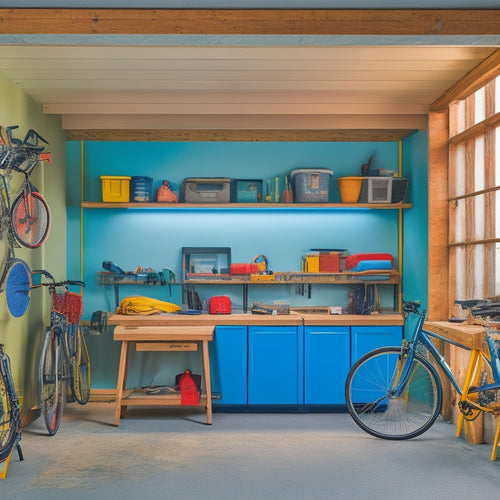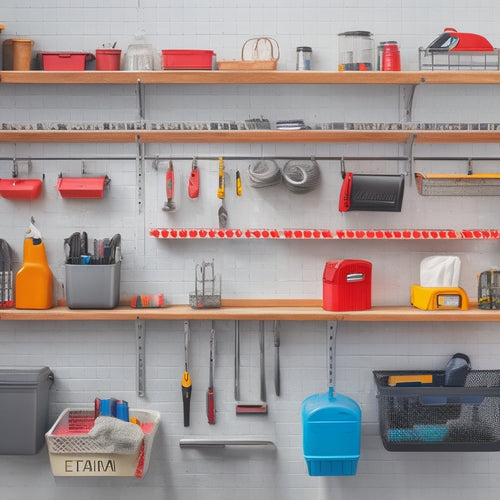
Organizing Boxes for a Clutter-Free Home in 5 Steps
Share
You're just five steps away from a clutter-free home! Start by sorting and purging box contents, letting go of items that don't serve a purpose or bring joy. Next, categorize and group boxes by contents and intended use, assigning durable boxes to fragile items. Then, designate a home for each box, using appropriate storage solutions and reserving harder-to-reach areas for less frequently used items. After that, label and sign each box for easy identification, using color-coding and concise descriptions. Finally, maintain your system by scheduling regular check-ins and keeping supplies on hand - and you'll be well on your way to a space that's organized, peaceful, and entirely yours.
Key Takeaways
- Sort and purge box contents by evaluating necessity, letting go of unnecessary items, and considering donation or recycling.
- Categorize and group boxes by contents, intended use, and durability, storing frequently used items in accessible locations.
- Assign a specific storage spot for each box, using appropriate storage solutions and ensuring easy access to contents.
- Label and sign each box clearly, using concise descriptions, color-coding, and initials for easy identification.
- Schedule regular check-ins to maintain box organization systems, reorganizing and updating labels as needed to prevent clutter.
Sort and Purge Box Contents
With your boxes gathered, it's time to plunge in and sort through their contents. This step can be challenging, but it's essential in achieving a clutter-free home.
Begin by opening each box and taking out the items one by one. As you handle each item, ask yourself if you really need it or if it's just taking up space. Be honest with yourself - if you haven't used it in the past year, it's likely you won't miss it.
Emotional attachment can make decluttering difficult, but remember that keeping something "just in case" often leads to clutter. Implement effective decluttering strategies by letting go of items that no longer serve a purpose or bring you joy.
Consider donating gently used items or recycling materials that can't be donated. As you sort through your belongings, create a "keep" pile for items you truly need or want, and a "discard" pile for items you're willing to let go of.
Categorize and Group Boxes
Now that you've purged your boxes of unwanted items, it's time to categorize and group them in a way that makes sense for your organized home.
Begin by grouping boxes by their contents, such as items for donation, storage, or disposal. Next, categorize boxes by their intended use, like seasonal decorations or out-of-season clothing. This will help you determine the most effective storage solutions for each group.
Consider the box materials and their durability when grouping them. For example, fragile items like ornaments or dishes should be stored in sturdy boxes with extra cushioning, while lighter items like linens or out-of-season clothes can be stored in lighter-weight boxes.
As you categorize and group your boxes, think about the frequency of use and accessibility. Store frequently used items in easy-to-reach locations, and reserve harder-to-reach areas for less frequently used items.
Assign a Home for Each Box
Assign a Home for Each Box
From the get-go, designate a specific spot for each box, ensuring that everything has its own assigned home within your organized space. This is essential for maintaining a clutter-free home, as it allows you to easily find what you need and prevents clutter from building up again.
When deciding on box placement, consider the following storage solutions:
| Box Type | Storage Solution |
| Seasonal Decorations | Attic or Garage Storage |
| Important Documents | File Cabinet or Safe |
| Kitchen Utensils | Kitchen Cabinets or Drawers |
| Cleaning Supplies | Laundry Room or Utility Closet |
| Linens and Bedding | Closet Shelves or Underbed Storage |
Label and Sign Each Box
You've designated a spot for each box, guaranteeing everything has its own assigned home within your organized space.
Now, it's time to confirm you can easily identify what's inside each box without having to rummage through them. Effective box labeling is key to maintaining a clutter-free home.
Take a marker or label maker and clearly write the contents of each box on multiple sides, so you can read the label from any angle. Be specific and concise with your labels, avoiding vague descriptions like "miscellaneous" or "stuff." Instead, use descriptive labels like "winter clothing" or "kitchen utensils."
Consider color-coding your labels to categorize similar items or to indicate which boxes belong in a specific room.
Finally, sign each box with your name or initials to guarantee that everyone in the household knows who the box belongs to.
Maintain Box Organization Systems
By putting a system in place to maintain your box organization, you'll assure it continues to serve you well over time. This involves implementing box maintenance strategies that guarantee your organized space remains clutter-free.
Schedule regular check-ins to review your box storage solutions and make adjustments as needed. This might mean reorganizing boxes that have become disheveled or updating labels to reflect changes in contents.
As you continue to use your boxes, you'll likely need to replenish supplies, such as packing paper or bubble wrap. Keep a stash of these essentials on hand to avoid last-minute scrambles.
Additionally, consider designating a specific area for box storage to prevent them from creeping back into your living space. By doing so, you'll maintain a safe and organized environment.
Frequently Asked Questions
How Do I Handle Sentimental Items That Are Hard to Part With?
When handling sentimental items, you're torn between keeping them and letting go. You prioritize memory preservation by taking photos or creating a digital archive, then consider keeping only a few select items with high sentimental value.
What Type of Boxes Are Best for Storing Fragile or Delicate Items?
You'll want to invest in sturdy, specialized boxes with built-in cushioning materials or add bubble wrap to protect fragile items during storage and transport.
Can I Use Boxes of Different Sizes for Better Storage Efficiency?
You're drowning in a sea of clutter, but using boxes of different sizes is a lifesaver for space optimization! You'll be a pro of storage efficiency by mixing and matching boxes, just remember to label each one clearly so you can find what you need in a snap.
How Often Should I Review and Update My Box Organization System?
You should review and update your box organization system regularly, ideally every 3-6 months, to maintain box maintenance and guarantee organization frequency that works for you, preventing clutter buildup and securing a safe living space.
Are There Any Specific Boxes Designed for Storing Electronic Cables?
You'll find specialized boxes designed for cable management, providing safe electronic storage. Look for boxes with dividers, Velcro straps, or zippered pouches to keep your cables organized, protected, and easy to access.
Conclusion
As you stand victorious in your clutter-free domain, the weight of chaos lifts, and a sense of serenity settles in. Your newly organized boxes are the unsung heroes, quietly holding together the fabric of your sanity. With every glance at your neatly labeled containers, you'll feel a rush of satisfaction and control, like a skilled conductor orchestrating a harmony of calm. Your home, once a cluttered jungle, is now a peaceful oasis, thanks to your 5-step box organization system.
Related Posts
-

7 Essential Foldable Workbenches for Garages
When selecting a foldable workbench for your garage, you'll want to contemplate factors such as space-saving design, ...
-

3 Simple Steps to a Garage Tool Wall You'll Love
To create a garage tool wall you'll love, start by planning the space, taking inventory of your tools, and measuring ...
-

Custom Pegboard Storage for Your Workshop
You're looking to create a custom pegboard storage system that maximizes your workshop's space, enhances productivity...


